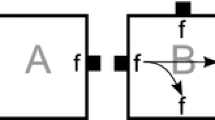Abstract
Sending signals through DNA-based structures is one of the methods used to enhance the capabilities of DNA self-assembly systems. Signal Tile Assembly Models at temperature one, in supertile-to-supertile attachment mode, have been showed to have universal computational power. We introduce a simplified signal tile assembly model, in one-tile-at-a-time attachment mode, and where signals can only be used to deactivate glues. We prove that such a simplified system at temperature one can still simulate a Turing machine. We also present a simplified signal tile assembly system, in supertile-to-supertile attachment mode, that assembles a thin, \(N \times N!\), rectangle and has tile complexity \(O(\log N)\). This result is an improvement over the tile complexity of existing models for thin rectangle self-assembly.















Similar content being viewed by others
References
Aggarwal G, Cheng Q, Goldwasser M, Kao M-Y, de Espanés PM, Schweller R (2005) Complexities for generalized models of self-assembly. SIAM J Comput 34(6):1493–1515
Behsaz B, Manuch J, Stacho L (2012) Turing universality of step-wise and stage assembly at temperature 1. In: DNA computing and molecular programming—international conference, DNA 18. Proceedings, volume 7433 of LNCS, pp 1–11
Chen H-L, Schulman R, Goel A, Winfree E (2007) Reducing facet nucleation during algorithmic self-assembly. Nano Lett 7(9):2913–2919
Cook M, Fu Y, Schweller R (2011) Temperature 1 self-assembly: deterministic assembly in 3D and probabilistic assembly in 2D. In: SODA, SIAM, pp 570–589
Demaine E, Demaine M, Fekete S, Ishaque M, Rafalin E, Schweller R, Souvaine D (2008) Staged self-assembly: nanomanufacture of arbitrary shapes with O(1) glues. Nat Comput 7(3):347–370
Doty D, Kari L, Masson B (2013) Negative interactions in irreversible self-assembly. Algorithmica 66(1):153–172
Fochtman T, Hendricks J, Padilla J, Patitz M, Rogers T (2015) Signal transmission across tile assemblies: 3D static tiles simulate active self-assembly by 2D signal-passing tiles. Nat Comput 14(2):251–264
Hendricks J, Patitz M, Rogers T (2015) Reflections on tiles (in self-assembly). In: Phillips A, Yin P (eds), DNA computing and molecular programming—international conference, DNA 21. Proceedings, volume 9211 of lecture notes in computer science, Springer, pp 55–70
Keenan A, Schweller R, Zhong X (2013) Exponential replication of patterns in the signal tile assembly model. In: DNA computing and molecular programming—international conference, DNA 19. Proceedings, volume 8141 of LNCS, pp 118–132
Padilla J, Liu W, Seeman N (2012) Hierarchical self assembly of patterns from the Robinson tilings: DNA tile design in an enhanced tile assembly model. Nat Comput 11:323–338
Padilla J, Patitz M, Pena R, Schweller R, Seeman N, Sheline R, Summers S, Zhong X (2013) Asynchronous signal passing for tile self-assembly: fuel efficient computation and efficient assembly of shapes. In: UCNC 2013, volume 7956 of LNCS, pp 174–185
Patitz M (2014) An introduction to tile-based self-assembly and a survey of recent results. Nat Comput 13(2):195–224
Patitz M, Schweller R, Summers S (2011) Exact shapes and Turing universality at temperature 1 with a single negative glue. In: Cardelli L, Shih WM (eds), DNA computing and molecular programming—international conference, DNA 17, volume 6937 of lecture notes in computer science, Springer, pp 175–189
Reif J, Sahu S, Yin P (2011) Complexity of graph self-assembly in accretive systems and self-destructible systems. Theor Comput Sci 412(17):1592–1605
Rothemund P, Winfree E (2000) The program-size complexity of self-assembled squares (extended abstract). In: Proceedings of the thirty-second annual acm symposium on theory of computing, pp 459–468
Seeman N (1982) Nucleic acid junctions and lattices. J Theor Biol 99(2):237–247
Winfree E (1998) Algorithmic self-assembly of DNA. Ph.D. thesis
Winfree E, Liu F, Wenzler L, Seeman N (1998) Design and self-assembly of two-dimensional DNA crystals. Nature 394:539–544
Winfree E, Yang X, Seeman N (1996) Universal computation via self-assembly of DNA: some theory and experiments. In: DNA based computers 1996, proceedings of a DIMACS workshop, pp 191–214
Author information
Authors and Affiliations
Corresponding author
Additional information
This research was supported by Natural Science and Engineering Council of Canada (NSERC) Discovery Grant R2824A01 to L.K.
Rights and permissions
About this article
Cite this article
Kari, L., Simjour, A. Simplifying the role of signals in tile self-assembly. Nat Comput 18, 383–401 (2019). https://doi.org/10.1007/s11047-018-9676-z
Published:
Issue Date:
DOI: https://doi.org/10.1007/s11047-018-9676-z




